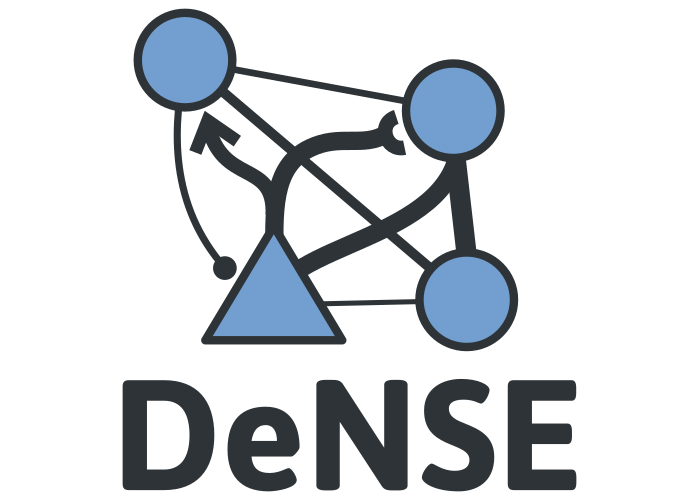Extension component¶
Extension dynamics, steering, and direction selection are the mechanisms which define the shape and the properties of the neurite. These three features are modeled separately in DeNSE and this page deals with the different implementations that are available for the extension component. The other two parts come after the computation of the target extension length and are detailed in the Steering component and Direction selection component pages.
Constant elongation¶
The simplest implementation, which is the default choice and the only model in other simulators such as NETMORPH or NeuroMac, is the constant elongation.
This method does not include any additional parameters since the growth cone
simply elongates with a constant speed speed_growth_cone for all timesteps.
For the detailed implementation, see growth::CstExtensionModel.
Note
The constant speed of this elongation model can still be changed
if the “speed decay” feature is used at the neurite level.
See Influence of the neurite and the speed_decay parameter.
Gaussian fluctuations¶
A slightly more complex implementation provides normal random fluctuations
around the average speed_growth_cone, allowing for a tentatively more
accurate description of some of the periods where growth cone exhibits
significant changes in their elongation behavior, notably recurrent switches
between elongation and retraction phases.
In the model, the fluctuations occur randomly, with zero correlation and a
standard deviation speed_variance (@todo change the name).
For the detailed implementation, see growth::GFluctExtensionModel.
Note
The average speed of this elongation model can be changed
if the “speed decay” feature is used at the neurite level.
See Influence of the neurite and the speed_decay parameter.
Resource-based elongation¶
In order to model the progressive changes in the growth cone speed, a more accurate model needs to account for the dynamics underlying these changes.
The resource-based implementation provides such a model of the extension
dynamics, building on studies such as [Hjorth2014]. It accounts for the
evolution of a critical resource necessary for microtubule polymerization and
stabilisation, e.g. MAPs, and the speed of the extension then depends on the
amount of the resource \(a\) that is present at the tip.
This model provides a significant number of parameters, separated into three main categories:
at the neurite levels, parameters associated to the evolution of the total amount of resource in the neurite, \(A\),
at the tip, parameters underlying the dynamics of the amount of resource, \(a\),
threshold values to compute the speed from \(a\).
The available amount \(a\) at the tip and the total amount \(A\) obey the following dynamics:
with \(\chi \in \mathcal{N}(0, \sigma_\chi)\) and \(\xi \in \mathcal{N}(0, \sigma_\xi)\) two normal random variables with respective standard deviations \(\sigma_\chi\) and \(\sigma_\xi\).
The variables in DeNSE can be set through (@todo change names, CR -> res?):
res_use_ratio(\(u\)), the fraction of the available amount \(a\) consumed in \(dt\) is \(u\cdot a\),res_leakage(\(\tau_l\)) (switch totau_leak?), the timescale of reasource leak outside of the growth cone,res_neurite_delivery_tau(\(\tau_d\)), the typical delivery timescale to the growth cone tip,res_variance(\(\sigma_\chi\)), the standard deviation of the \(a\)-noise,res_neurite_variance(\(\sigma_\xi\)), the standard deviation of the \(A\)-noise,res_neurite_generated(\(A_m\)), the target amount of resource that will be generated in the neurite,res_neurite_generated_tau(\(\tau_A\)), the typical timescale for resource generation in the neurite.
Once the amount of resource at the tip has been computed, the extension speed of the growth cone is computed based on a 3-threshold rule:
with the variable names in DeNSE:
res_elongation_threshold(\(\theta_e\)), the elongation threshold,res_retraction_threshold(\(\theta_r\)), the retraction threshold,res_elongation_factor(\(v_e\)), the maximum elongation speed (rename tores_max_elongation_speed?),res_retraction_factor(\(v_r\)), the maximum retraction speed (rename tores_max_retraction_speed?).
In order to adapt its resource production to the number of growth cones present, the target amount produced by the neurite is actually not constant, but grows with the number \(n_{gc}\) of growth cones, following the equation:
with:
res_typical_gc_support(\(n_0\)) the typical number of growth cone for one neuriteres_increase_slope(\(s\)) the increase in \(A_m\) with each new growth cone (1 by default).
For the detailed implementation, see
growth::ResourceBasedExtensionModel.
Note
Because it intrisically accounts for the number of growth cones
in the neurite, this model is not compatible (or at least it is not
affected) by the “speed decay” feature: changes in the number of
growth cones will only change based on the parameters discussed
above and do not depend on the speed_decay parameter.
See Influence of the neurite for more information about this feature
and how it can be used with the other elongation models.
References¶
- Hjorth2014
Hjorth, Van Pelt, Mansvelder & Van Ooyen (2014). Competitive dynamics during resource-driven neurite outgrowth. PLoS One, 9.
